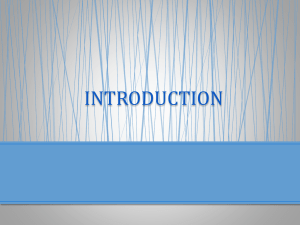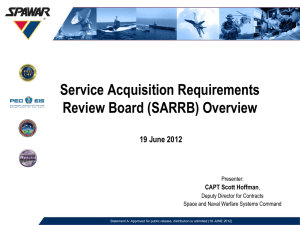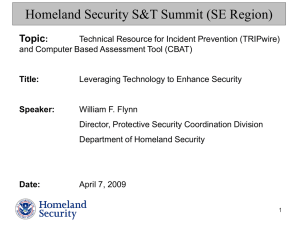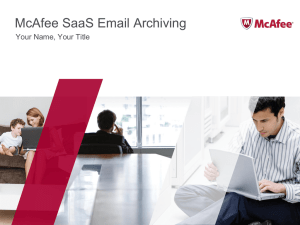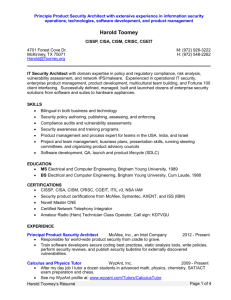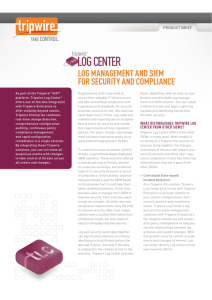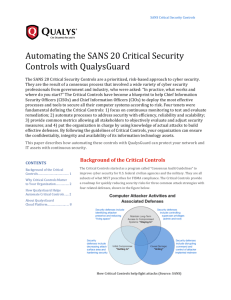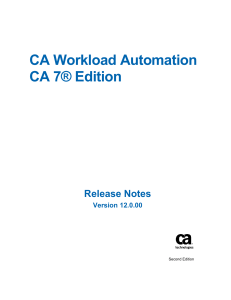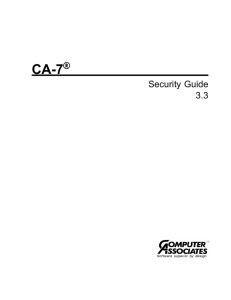Critical Security Controls Poster
advertisement
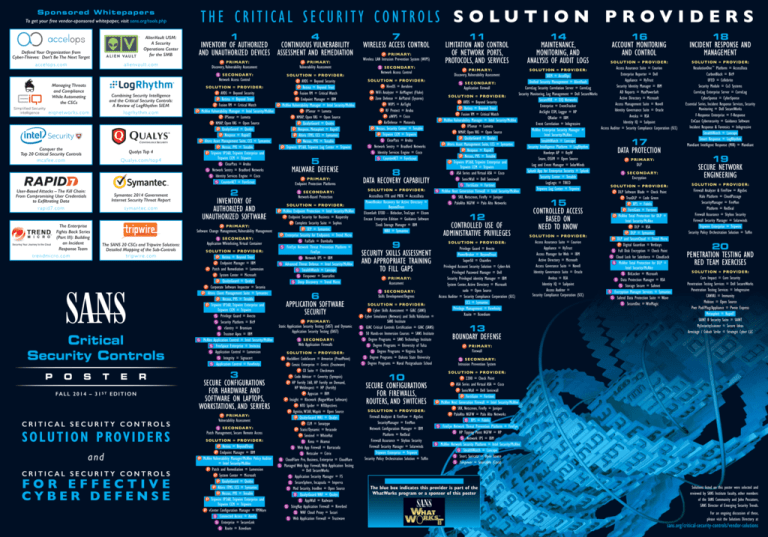
S p o n s o r e d W hi t e p a pe rs To get your free vendor-sponsored whitepaper, visit sans.org/tools.php AlienVault USM: A Security Operations Center for the SMB Defend Your Organization from Cyber-Thieves: Don’t Be The Next Target accelops.com alienvault.com THE CRITICAL SECURITY CONTROLS S O L U T I O N P R O V I D E R S 1 4 Inventory of Authorized Continuous Vulnerability and Unauthorized Devices Assessment and Remediation PRIMARY: Discovery, Vulnerability Assessment SECONDARY: Network Access Control Managing Threats and Compliance While Automating the CSCs SOLUTION = PROVIDER: Combining Security Intelligence and the Critical Security Controls: A Review of LogRhythm SIEM logr hythm .com e i q n e t wo r k s .c o m Conquer the Top 20 Critical Security Controls Qualys Top 4 m c a fe e .c o m Q ualys.com /top 4 User-Based Attacks – The Kill Chain: From Compromising User Credentials to Exfiltrating Data Symantec 2014 Government Internet Security Threat Report r a p i d 7 .c o m sym antec .com The Enterprise Fights Back Series (Part III): Building an Incident Response Team t ren d mi c r o. c o m O PRIMARY: SECONDARY: The SANS 20 CSCs and Tripwire Solutions: Detailed Mapping of the Sub-Controls tr ip w ir e .com S 2 Inventory of Authorized and Unauthorized Software Software Change Management, Vulnerability Management Critical Security Controls P AVDS = Beyond Security Retina = Beyond Trust Fusion VM = Critical Watch McAfee Vulnerability Manager = Intel Security/McAfee IPSonar = Lumeta NMAP, Open VAS = Open Source QualysGuard = Qualys Nexpose = Rapid7 Altiris Asset Management Suite, CCS = Symantec Nessus, PVS = Tenable Tripwire IP360, Tripwire Enterprise and Tripwire CCM = Tripwire ClearPass = Aruba Network Sentry = Bradford Networks Identity Services Engine = Cisco CounterACT = ForeScout T E R FA L L 2 0 1 4 – 3 1 s t E D I T I O N Application Whitelisting, Virtual Container SOLUTION = PROVIDER: Retina = Beyond Trust Endpoint Manager = IBM Patch and Remediation = Lumension System Center = Microsoft QualysGuard = Qualys Corporate Software Inspector = Secunia Altiris Client Management Suite = Symantec Nessus, PVS = Tenable Tripwire IP360, Tripwire Enterprise and Tripwire CCM = Tripwire Privilege Guard = Avecto Security Platform = Bit9 vSentry = Bromium Trusteer Apex = IBM McAfee Application Control = Intel Security/McAfee FreeSpace Enterprise = Invincea Application Control = Lumension Integrity = Signacert Application Control = Viewfinity 3 Secure Configurations for Hardware and Software on Laptops, Workstations, and Servers PRIMARY: CRITICAL SECURITY CONTROLS S O L U T I O N P ROV I D E R S and CRITICAL SECURITY CONTROLS FOR EFFECTIVE CYBER DEFENSE Vulnerability Assessment SECONDARY: Patch Management, Secure Remote Access SOLUTION = PROVIDER: Retina = BeyondTrust Endpoint Manager = IBM McAfee Vulnerability Manager/McAfee Policy Auditor = Intel Security/McAfee Patch and Remediation = Lumension System Center = Microsoft QualysGuard = Qualys Altiris ITMS, CCS = Symantec Nessus, PVS = Tenable Tripwire IP360, Tripwire Enterprise and Tripwire CCM = Tripwire vCenter Configuration Manager = VMWare Connected Access = Axeda Enterprise = SecureLink Xsuite = Xceedium PRIMARY: Vulnerability Assessment SOLUTION = PROVIDER: AVDS = Beyond Security Retina = Beyond Trust Fusion VM = Critical Watch Endpoint Manager = IBM McAfee Vulnerability Manager = Intel Security/McAfee IPSonar = Lumeta NMAP, Open VAS = Open Source QualysGuard = Qualys Nexpose, Metasploit = Rapid7 Altiris ITMS, CCS = Symantec Nessus, PVS = Tenable Tripwire IP360, Tripwire Log Center = Tripwire 5 Malware Defense PRIMARY: Endpoint Protection Platforms SECONDARY: Network-Based Protection SOLUTION = PROVIDER: McAfee Endpoint Protection = Intel Security/McAfee Endpoint Security for Business = Kaspersky Complete Security Suite = Sophos SEP = Symantec Enterprise Security for Endpoints = Trend Micro FailSafe = Damballa FireEye Network Threat Prevention Platform = FireEye Network IPS = IBM Advanced Threat Defense = Intel Security/McAfee StealthWatch = Lancope Firepower = Sourcefire Deep Discovery = Trend Micro 6 Application Software Security PRIMARY: Static Application Security Testing (SAST) and Dynamic Application Security Testing (DAST) SECONDARY: Web Application Firewalls SOLUTION = PROVIDER: HackAlert CodeSecure = Armorize (ProofPoint) Cenzic Enterprise = Cenzic (Trustwave) CX Suite = Checkmarx Code Advisor = Coverity (Synopsis) HP Fortify 360, HP Fortify on Demand, HP WebInspect = HP (Fortify) Appscan = IBM Insight = Klocwork (RogueWave Software) NTO Spider = NTObjectives Agnitio, W3AF, Wapiti = Open Source QualysGuard WAS = Qualys CLM = Sonatype Static/Dynamic = Veracode Sentinel = WhiteHat Kona = Akamai Web App Firewall = Barracuda Netscaler = Citrix CloudFlare Pro, Business, Enterprise = Cloudflare Managed Web App Firewall, Web Application Testing = Dell SecureWorks Application Security Manager = F5 SecureSphere, Incapsula = Imperva Mod Security, IronBee = Open Source QualysGuard WAF = Qualys AppWall = Radware StingRay Application Firewall = Riverbed WAF Cloud Proxy = Sucuri Web Application Firewall = Trustwave 7 Wireless Access Control PRIMARY: Wireless LAN Intrusion Prevention System (WIPS) SECONDARY: Network Access Control SOLUTION = PROVIDER: HiveOS = Aerohive WiFi Analyzer = AirMagnet (Fluke) Zone Defense = AirPatrol (Sysorex) WIPS = AirTight RF Protect = Aruba aWIPS = Cisco AirDefense = Motorola Nessus, Security Center = Tenable Tripwire CCM = Tripwire ClearPass = Aruba Network Sentry = Bradford Networks Identity Services Engine = Cisco CounterACT = ForeScout 8 Data Recovery Capability SOLUTION = PROVIDER: AccessData FTK and PRTK = AccessData PowerBroker Recovery for Active Directory = BeyondTrust ElcomSoft EFDD – Bitlocker, TruCrypt = Elcom Encase Enterprise Edition = Guidance Software Tivoli Storage Manager = IBM NBU = Symantec 9 Security Skills Assessment and Appropriate Training to Fill Gaps PRIMARY: Assessment SECONDARY: Skills Development/Degrees SOLUTION = PROVIDER: Cyber Skills Assessment = GIAC (SANS) Cyber Simulators (Netwars) and Skills Validation = SANS Institute GIAC Critical Controls Certification = GIAC (SANS) 50 Hands-on Immersion Courses = SANS Institute Degree Programs = SANS Technology Institute Degree Programs = University of Tulsa Degree Programs = Virginia Tech Degree Programs = Dakota State University Degree Programs = Naval Postgraduate School 10 Secure Configurations for Firewalls, Routers, and Switches SOLUTION = PROVIDER: Firewall Analyzer & FireFlow = AlgoSec SecurityManager = FireMon Network Configuration Manager = IBM Platform = RedSeal Firewall Assurance = Skybox Security Firewall Security Manager = Solarwinds Tripwire Enterprise = Tripwire Security Policy Orchestration Solution = Tuffin 11 Limitation and Control of Network Ports, Protocols, and Services 14 Maintenance, Monitoring, and Analysis of Audit Logs 16 Account Monitoring and Control 18 Incident Response and Management SOLUTION = PROVIDER: SOLUTION = PROVIDER: Access Assurance Suite = Courion Enterprise Reporter = Dell Discovery, Vulnerability Assessment SIEM = AccelOps Appliance = HyTrust Unified Security Management = AlienVault SECONDARY: Security Identity Manager = IBM CorreLog Security Correlation Server = CorreLog Application Firewall AD Reports = MaxPowerSoft Security Monitoring, Log Management = Dell SecureWorks SOLUTION = PROVIDER: Active Directory = Microsoft SecureVUE = EIQ Networks AVDS = Beyond Security Access Management Suite = Novell Enterprise = EventTracker Retina = Beyond Trust Identity Governance Suite = Oracle ArcSight ESM, Logger = HP Fusion VM = Critical Watch Aveska = RSA QRadar = IBM McAfee Vulnerability Manager = Intel Security/McAfee Identity IQ = Sailpoint Event Correlation = Infogressive IPSonar = Lumeta Access Auditor = Security Compliance Corporation (SCC) McAfee Enterprise Security Manager = NMAP, Open VAS = Open Source Intel Security/McAfee QualysGuard = Qualys StealthWatch = Lancope Altiris Asset Management Suite, CCS = Symantec Security Intelligence Platform = LogRhythm Nexpose = Rapid7 Hawkeye AP = KeyW Nessus, PVS = Tenable Snare, OSSIM = Open Source PRIMARY: Tripwire IP360, Tripwire Enterprise and DLP Log and Event Manager = SolarWinds Tripwire CCM = Tripwire Splunk App for Enterprise Security = Splunk SECONDARY: ASA Series and Virtual ASA = Cisco Security Center = Tenable Encryption SonicWall = Dell Sonicwall LogLogic = TIBCO FortiGate = Fortinet SOLUTION = PROVIDER: Tripwire Log Center = Tripwire McAfee Next Generation Firewall = Intel Security/McAfee DLP Software Blade = Check Point SRX, Netscreen, Firefly = Juniper TrueDLP = Code Green PaloAlto NGFW = Palo Alto Networks XPS = Fidelis FortiGate = Fortinet McAfee Total Protection for DLP = Intel Security/McAfee DLP = RSA DLP = Symantec SOLUTION = PROVIDER: DLP and SecureCloud = Trend Micro Access Assurance Suite = Courion SOLUTION = PROVIDER: Digital Guardian = Verdasys Appliance = HyTrust Privilege Guard = Avecto Full Disk Encryption = Check Point Access Manager for Web = IBM PowerBroker = BeyondTrust Cloud Lock for Salesforce = CloudLock Active Directory = Microsoft SuperSU = Chainfire McAfee Total Protection for DLP = Access Goverance Suite = Novell Privileged Account Security Solution = Cyber-Ark Intel Security/McAfee Identity Governance Suite = Oracle Privileged Password Manager = Dell BitLocker = Microsoft Aveksa = RSA Security Privileged identity Manager = IBM Data Protection Manager = RSA Identity IQ = Sailpoint System Center, Active Directory = Microsoft Storage Secure = Safenet Access Auditor = sudo = Open Source Encryption Manager Services = Symantec Security Compliance Corporation (SCC) Access Auditor = Security Compliance Corporation (SCC) Safend Data Protection Suite = Wave CCS = Symantec SecureDoc = WinMagic Privilege Management = Viewfinity Xsuite = Xceedium PRIMARY: SOLUTION = PROVIDER: 17 Data PROTECTION 12 Controlled Use of Administrative Privileges 13 Boundary Defense 15 Controlled Access Based on Need to Know ResolutionOne™ Platform = AccessData CarbonBlack = Bit9 UFED = Cellebrite Security Module = Co3 Systems CorreLog Enterprise Server = CorreLog CyberSponse = CyberSponse Essential Series, Incident Response Services, Security Monitoring = Dell SecureWorks F-Response Enterprise = F-Response EnCase Cybersecurity = Guidance Software Incident Response & Forensics = Infogressive StealthWatch = Lancope Smart Response = LogRhythm Mandiant Intelligent Response (MIR) = Mandiant 19 Secure Network Engineering SOLUTION = PROVIDER: Firewall Analyzer & FireFlow = AlgoSec Halo Platform = CloudPassage SecurityManager = FireMon Platform = RedSeal Firewall Assurance = Skybox Security Firewall Security Manager = Solarwinds Tripwire Enterprise = Tripwire Security Policy Orchestration Solution = Tuffin 20 Penetration Testing and Red Team Exercises SOLUTION = PROVIDER: Core Impact = Core Security Penetration Testing Services = Dell SecureWorks Penetration Testing Services = Infogressive CANVAS = Immunity Mobisec = Open Source Pwn Pad/Plug/Appliance = Pwnie Express Metasploit = Rapid7 SAINT 8 Security Suite = SAINT MySecurityScanner = Secure Ideas Armitage / Cobalt Strike = Strategic Cyber LLC PRIMARY: Firewall SECONDARY: Intrusion Prevention System SOLUTION = PROVIDER: 2200 = Check Point ASA Series and Virtual ASA = Cisco SonicWall = Dell Sonicwall FortiGate = Fortinet McAfee Next Generation Firewall = Intel Security/McAfee SRX, Netscreen, Firefly = Juniper PaloAlto NGFW = Palo Alto Networks XPS = Fidelis FireEye Network Threat Prevention Platform = FireEye HP Tipping Point NGFW = HP Network IPS = IBM McAfee Network Security Platform = Intel Security/McAfee StealthWatch = Lancope Snort, Suricata = Open Source Firepower = Sourcefire (Cisco) The blue box indicates this provider is part of the WhatWorks program or a sponsor of this poster Solutions listed on this poster were selected and reviewed by SANS Institute faculty, other members of the SANS Community and John Pescatore, SANS Director of Emerging Security Trends. For an ongoing discussion of these, please visit the Solutions Directory at sans.org/critical-security-controls/vendor-solutions Critical Effective Cybersecurity – Now The Critical Security Controls for Effective Cyber Defense (the Controls) are a recommended set of actions for cyber defense that provide specific and actionable ways to stop today’s most pervasive and dangerous attacks. They are developed, refined, validated, and supported by a large volunteer community of security experts under the stewardship of the Council on CyberSecurity (www.counciloncybersecurity.org). Contributors, adopters, and supporters are found around the world, and represent every type of role, experience, and mission or business. State and local governments, power generation and distribution, transportation, academic institutions, financial services, Federal government, defense contractors, and many more – are among the hundreds of organizations that have shifted from a compliance focus to a security focus by adopting the Critical Security Controls. All of these entities changed over to the Controls in answer to the key question: “What needs to be done right now to protect my organization from advanced and targeted attacks?” Security for Effective Cyber Defense Critical Security Control NIST Core Framework PCI DSS 3.0 ISO 27002: 2013 DHS CDM Program Australian Top 35 2.4 A.8.1.1 A.9.1.2 A.13.1.1 Configuration Settings Management 1 14 17 A.12.5.1 A.12.6.2 Hardware Asset Management Software Asset Management 2.2 2.3 6.2 11.5 A.14.2.4 A.14.2.8 A.18.2.3 Configuration Settings Management 2-5 21 Vulnerability Management 2-3 1 Actively manage (inventory, track, and correct) all hardware devices on the network so that only authorized devices are given access, and unauthorized and unmanaged devices are found and prevented from gaining access. ID.AM-1 ID.AM-3 PR.DS-3 The Controls do not attempt to replace comprehensive frameworks, (e.g., NIST SP 800-53, ISO 27001, the NIST Cyber Security Framework) but rather prioritize and focus on a smaller number of actionable controls with high-payoff, aiming for a “must do first” philosophy. Since the Controls are derived from the most common attack patterns and vetted across a very broad community of government and industry security practitioners, with very strong consensus on the resulting set of controls, they serve as the basis for immediate high-value action. An enterprise can use the Controls to rapidly define the starting point to assess and improve their defenses, direct their scarce resources on actions with immediate and high-value payoff, and then focus their attention and resources on additional risk issues that are unique to their mission or business. An underlying theme of the Controls is support for large-scale, standards-based security automation for the management of cyber defenses. 2 Inventory of Authorized and Unauthorized Software Actively manage (inventory, track, and correct) all software on the network so that only authorized software is installed and can execute, and that unauthorized and unmanaged software is found and prevented from installation or execution. ID.AM-2 PR.DS-6 3 Secure Configurations for Hardware and Software Establish, implement, and actively manage (track, report on, correct) the security configuration of laptops, servers, and workstations using a rigorous configuration management and change control process in order to prevent attackers from exploiting vulnerable services and settings. PR.IP-1 4 Continuous Vulnerability Assessment and Remediation Continuously acquire, assess, and take action on new information in order to identify vulnerabilities, remediate, and minimize the window of opportunity for attackers. ID.RA-1 DE.CM-8 ID.RA-2 RS.MI-3 PR.IP-12 6.1 6.2 11.2 A.12.6.1 A.14.2.8 The Controls illustrate the kind of large-scale, public-private, voluntary cooperation needed to improve individual and collective security in cyberspace. Too often in cybersecurity, it seems the “bad guys” are better organized and collaborate more closely than the “good guys.” The Controls provide a means to turn that around. 5 Malware Defenses Control the installation, spread, and execution of malicious code at multiple points in the enterprise, while optimizing the use of automation to enable rapid updating of defense, data gathering, and corrective action. PR.PT-2 DE.CM-4 DE.CM-5 5.1 - 5.4 A.8.3.1 A.12.2.1 A.13.2.3 PR.DS-7 A.9.4.5 6.3 A.12.1.4 A.14.2.1 6.5 - 6.7 A.14.2.6 - A.14.2.8 Mapping the Controls Across the Cyber Defense Lifecycle The Critical Controls provide high value across different stages of the typical “Prevent/Detect/Respond” cybersecurity lifecycle. SANS has created a mapping allocating the Controls across four phases: C ritical S ecurity C ontrols C y b er Resource Hardening Hardware and Software Inventory CSC1 & CSC2 Secure Configurations CSC3, CSC7, CSC10 & CSC11 Vulnerability Assessment & Application Security CSC4 & CSC6 D e f ense L i f e C ycle Privilege and Access Management Admin Privileges Attack Detection/Mitigation Malware Defenses Compromise Detection, Response, Recovery, and Reporting Data Recovery Controlled Access Boundary Defense Audit CSC12 CSC15 CSC5 CSC13 Account Managing CSC8 CSC14 Data Protection CSC16 CSC17 People and Processes The Critical Security Controls includes a number of security areas which focus on people and processes and are applicable across the entire lifecycle: CSC9 – Security Skills Assessment and Training CSC19 – Secure Network Engineering CSC20 – Penetration Testing and Red Team Exercises Incident Response CSC18 The Department of Homeland Security Continuous Diagnostics and Mitigation program has multiple phases of security product and services offerings across cybersecurity. The Critical Controls map directly against those CDM phases: Manage Assets Hardware Inventory Security Skills Software Inventory & Malware Defenses Admin Privileges CSC1 C ritical S ecurity C ontrols C D M C a p a b ility Families Manage Accounts for People and Services Manage Events CSC2 & CSC5 Vulnerability Assessment & Application Security CSC4 & CSC6 Wireless Access Control CSC9 Data Recovery Security Engineering Audit Red Team/Pen Testing CSC8 CSC12 CSC14 Controlled Access Incident Response CSC15 Manage Security Lifecycle CSC19 CSC20 CSC18 Account Monitoring CSC16 CSC7 Secure Configurations CSC3 & CSC10 Boundary Defense & Ports, Protocols, and Service CSC13 & CSC11 Data Protection CSC17 CDM is being deployed in three phases: Phase 1 (yellow): Hardware, Software, Configuration Settings, and Vulnerability Management Phase 2 (orange): Managing Trust, Security-Related Behavior, Credentials and Authentication, Privileges and Accounts, and Filter-Based Boundaries Phase 3 (red): Managing Physical and Virtual (Encryption) Boundaries, Incident Planning, Incident Response, Suspicious Pattern Detection, Enterprise Planning and Policy, Quality Management, and Risk Management. The Value of Using the Critical Security Controls to Focus on Protecting Critical Information Assets The Critical Security Controls are not intended to replace any of the major security frameworks, such as ISO 27001, the NIST Cybersecurity Framework, the Payment Card Industry Data Security Standards, etc. In the real world, auditors will still perform audits across those complex, exhaustive frameworks. However, adopting the Controls allows you to convince your management and those auditors that you have focused on the most important security processes first in both your current and planned efforts – which is what risk management is all about. Larry Wilson was hired by the University of Massachusetts in 2009 as the UMASS President’s Office Information Security Lead. His primary role was to develop a University-wide Information Security Policy and Written Information Security Program (WISP). He formed an information security controls team with representatives from all five campuses (Amherst, Dartmouth, Lowell, Worcester, and Boston). The controls team established a standards-based program consisting of management, administrative/operational and technical controls. Management and administrative/ operational security controls (also called General Computer Controls) are based on ISO 27001 / 27002. The technical security controls are based on Critical Security Controls implemented as the “inner core” to protect “Critical Information Assets.” This has allowed UMASS to increase the maturity of their security controls to actively mitigate advanced threats, resulting in both fewer incidents and faster response to incidents that do occur. UMASS implemented the Critical Controls with an initial focus of protecting critical resources and information assets but under an architecture that supported scalability and integration to pave the way for broader deployment. The controls team also advised the internal audit department and executive management on the importance of this approach. In May, 2014, Larry helped organize a week-long training event where 68 individuals representing 32 local colleges and universities received in depth training on the Critical Security Controls. Application Software Security Manage the security lifecycle of all in-house developed and acquired software in order to prevent, detect, and correct security weaknesses. Wireless Access Control The processes and tools used to track/control/prevent/correct the security use of wireless local area networks (LANS), access points, and wireless client systems. 8 Data Recovery Capability The processes and tools used to properly back up critical information with a proven methodology for timely recovery of it. 9 Security Skills Assessment and and its security), identify the specific knowledge, skills, and abilities needed to support of the enterprise; develop and execute an integrated plan to assess, identify gaps, Appropriate Training to Fill Gaps defense and remediate through policy, organizational planning, training, and awareness programs. 7 PR.IP-4 For all functional roles in the organization (prioritizing those mission-critical to the business PR.AT-1 PR.AT-4 PR.AT-2 PR.AT-5 PR.AT-3 4.3 11.1 A.10.1.1 A.12.4.1 A.12.7.1 4.3 9.5 - 9.7 A.10.1.1 A.12.3.1 GCHQ 10 Steps Secure Configuration 7 26 Removable Media Controls 17 30 22 Malware Protection Vulnerability Management 12.6 A.7.2.2 1.1 - 1.2 2.2 6.2 A.9.1.2 A.13.1.1 A.13.1.3 Configuration Settings Management Boundary Protection 2 3 10 Boundary Protection 2 13 3 27 12 11 1.4 A.9.1.2 A.13.1.1 A.13.1.2 A.14.1.2 12 Controlled Use of Administrative Privileges The processes and tools used to track/control/prevent/correct the use, assignment, and configuration of administrative privileges on computers, networks, and applications. PR.AC-4 PR.MA-2 PR.AT-2 PR.PT-3 2.1 7.1 - 7.3 8.1 - 8.3 8.7 A.9.1.1 A.9.2.2 - A.9.2.6 A.9.3.1 A.9.4.1 - A.9.4.4 4 9 Detect/prevent/correct the flow of information transferring networks of different trust levels with a focus on security-damaging data. PR.AC-3 PR.MA-2 PR.AC-5 DE.AE-1 1.1 - 1.3 8.3 10.8 11.4 A.9.1.2 A.13.1.1 A.12.4.1 A.13.1.3 A.12.7.1 A.13.2.3 Boundary Protection 10-11 18-20 23 32-34 14 Maintenance, Monitoring, and Analysis of Audit Logs Collect, manage, and analyze audit logs of events that could help detect, understand, or recover from an attack. PR.PT-1 DE.DP-3 A.12.4.1 - A.12.4.4 DE.AE-3 DE.DP-4 DE.DP-1 DE.DP-5 10.1 - 10.7 A.12.7.1 DE.DP-2 Generic Audit Monitoring 15-16 35 Monitoring 15 Controlled Access Based on the Need to Know The processes and tools used to track/control/prevent/correct secure access to critical assets (e.g., information, resources, systems) according to the formal determination of which persons, computers, and applications have a need and right to access these critical assets based on an approved classification. PR.AC-4 PR.DS-2 PR.AC-5 PR.PT-2 PR.DS-1 PR.PT-3 1.3 - 1.4 4.3 7.1 - 7.3 8.7 A.8.3.1 A.9.1.1 A.10.1.1 Access Control Management Privileges 26 Managing User Privileges Network Security 16 Account Monitoring and Control Actively manage the life-cycle of system and application accounts – their creation, use, dormancy, deletion - in order to minimize opportunities for attackers to leverage them. PR.AC-1 PR.AC-4 PR.PT-3 7.1 - 7.3 8.7 - 8.8 A.9.1.1 A.9.2.1 - A.9.2.6 A.9.3.1 A.9.4.1 - A.9.4.3 A.11.2.8 Credentials and Authentication Management 3.6 4.1 - 4.3 A.8.3.1 A.10.1.1 - A.10.1.2 A.13.2.3 A.18.1.5 12.10 A.6.1.3 A.7.2.1 A.16.1.2 A.16.1.4 - A.16.1.7 19 Secure Network Engineering Make security an inherent attribute of the enterprise by specifying, designing, and building-in features that allow high confidence systems operations while denying or minimizing opportunities for attackers. 20 Penetration Tests and Red Team Exercises Test the overall strength of an organization’s defenses (the technology, the processes, and the people) by simulating the objectives and actions of an attacker. 18 *NIST 800-53 LISTINGS A-3: Device Identification and Authentication A-5: Authenticator Management AC-1: Access Control Policy and Procedures AC-2: Account Management AC-3: Access Enforcement AC-4: Information Flow Enforcement AC-6: Least Privilege AC-7: Unsuccessful Logon Attempts AC-11: Session Lock AC-12: Session Termination AC-17: Remote Access AC-18: Wireless Access 11.3 11 25 25 26 Plan for Events Respond to Events A.13.1.3 A.14.2.5 PR.AC-5 CA-7 CM-10 SC-34 CM-2 CM-11 SI-4 CM-8 SA-4 PM-5 SC-18 Every senior company executive and Board director should know that four or five steps of basic cybersecurity hygiene prevent 80-90% of all known attacks. Where does your business stand on basic cyber hygiene? Give your organization this simple “smell test.” CA-7 CM-6 CM-11 SC-14 Ask your business, IT, and security managers the following questions to see where your enterprise stands: Inappropriate locations CM-2 CM-7 MA-4 SC-34 for processing data CM-3 CM-8 RA-5 SI-2 CM-5 CM-9 SA-4 SI-4 CA-2 SC-34 CA-7 SI-4 RA-5 SI-7 Software Updates CA-7 SC-39 SC-44 Malware Protection SI-3 SI-4 SI-8 SA-13 SA-15 SA-16 SA-17 SA-20 SA-21 SC-39 SI-10 SI-11 SI-15 SI-16 AC-18 AC-19 CA-3 CA-7 CM-2 IA-3 SC-8 SC-17 SC-40 SI-4 AT-1 AT-4 PM-13 AT-2 SA-11 PM-14 AT-3 SA-16 PM-16 Network Security Decommissioning of software or services Unnecessary Services AC-4 CA-7 CA-9 CM-2 Monitoring Configuration of SSL and TLS Default Credentials AC-2 AC-19 IA-4 AC-6 CA-7 IA-5 AC-17 IA-2 SI-4 Home and Mobile Working Monitoring Network Security Managing User Privileges Access Control CA-7 SC-7 AC-17 CA-9 SC-8 Boundary firewalls and Inappropriate locations for AC-20 CM-2 SI-4 internet gateways processing data CA-3 AC-23 AU-2 AU-3 AU-4 AU-5 AU-6 AU-7 AU-8 SA-9 AC-1: Access Control AC-6 RA-2 MP-3 Access Control Configuration of SSL and TLS AC-2 AC-12 SC-17 AC-3 CA-7 SC-23 AC-7 IA-5 SI-4 AC-11 IA-10 AC-3 CA-9 SC-8 SI-4 AC-4 IR-9: SC-28: AC-23 MP-5 SC-31 CA-7 SA-18 SC-41 Removable Media Controls IR-1 IR-2 IR-3 Inappropriate locations for processing data Network Security A.14.2.8 A.18.2.1 A.18.2.3 1. Do we know what is connected to our systems and networks? 2. Do we know what’s running (or trying to run) on our systems and networks? 3.Are we limiting and managing the number of people who have the administrative privileges to change, bypass, or override the security settings on our systems and networks? 4.Do we have in place continuous processes backed by security technologies that would allow us to prevent most breaches, rapidly detect all that do succeed and minimize damage to our business and our customers? 5. Can you demonstrate all this to me, to our Board, and to our shareholders and customers today? If they can’t say yes to all these questions, you may still be compliant with regulations but your company’s data and customers are not safe. If you don’t ask these questions, your customers and shareholders will – or will be soon, because we are spreading the word! Give your corporate management the plan for how to say yes to those five questions! Getting Started: Ask and Answer Key Questions • W hat are my gaps? For each business- or mission critical asset, compare existing security controls against the Critical Controls, indicating the subcontrols that the existing controls already meet and those they do not meet. • W hat are my priorities? Based on your identified gaps and specific business risks and concerns, take immediate tactical steps to implement the five quick wins and develop a strategic plan to implement beyond the first five. • W here can I automate? As you plan implementation of the Controls, focus on opportunities to create security processes that can be integrated and automated using tools that relieve skilled security and administrative staff of grunt work and continuous monitoring processes. The Controls were specifically created to enable automation. The goal is to more rapidly and efficiently deliver accurate, timely, and actionable information to the system administrators and others who can take proactive steps to deter threats. • H ow can my vendor partners help? Some vendor solutions significantly improve and automate implementation of the Critical Controls, especially in terms of continuous monitoring and mitigation. Contact your current vendors to see how they can support your implementation of the Critical Controls and compare their capabilities with other vendor products with user validation at sans.org/critical-security-controls/vendor-solutions. • Where can I learn more? See the list of resources at the bottom of this poster. AU-9 AU-13 SI-4 AU-10 AU-14 AU-11 CA-7 AU-12 IA-10 Inappropriate locations for AC-2: AC-24 SC-16 AC-3 CA-7 SI-4 processing data Incident Management 10 CM-6 SC-22 CM-8 SC-41 SC-20 SI-4 SC-21 Configuration of SSL and TLS AC-4 Jane’s “elevator pitch” to corporate and government leaders: • W hat am I trying to protect? Create a prioritized list of business- or mission-critical processes and inventory the information and computing assets that map to those processes. This information will be crucial for baselining your current capabilities against the Critical Controls. Boundary firewalls and AC-4 CM-2 CM-8 Secure Software Updates internet gateways CA-3 CM-3 MA-4 Configuration Secure Configuration Inappropriate locations for CA-7 CM-5 SC-24 processing data Network Security Patch Management CA-9 CM-6 SI-4 PR.AC-5 DE.AE-1 Protect the organization’s information, as well as its reputation, by developing and implementing an incident response infrastructure (e.g., plans, defined roles, training, communications, management oversight) for quickly discovering an attack and then effectively containing the damage, eradicating the attacker’s presence, and restoring the integrity of the network and systems. Decommissioning of software or services 28 Manage (track/control/correct) the ongoing operational use of ports, protocols, and services on networked devices in order to minimize windows of vulnerability available to attackers. Incident Response and Management CA-7 CM-8 SC-17 IA-3: SI-4 SA-4 PM-5 User Education & Awareness Limitation and Control of Network Ports PR.IP-10 RS.RP-1 RC.RP-1 DE.AE-2 RS.CO-1-5 RC.IM-1-2 DE.AE-4 RS.AN-1-4 RC.CO-1-3 DE.AE-5 RS.MI-1-2 DE.CM-1-7 RS.IM-1-2 Inappropriate locations for processing data CP-9 CP-10 MP-4 10 17 Data Protection NIST 800-53 rev4* Monitoring Network Security Security-Related Behavior Management Gaining widespread adoption of the Critical Security Controls has been a bottoms-up movement, and getting buy-in from senior management early has enabled adopters to accelerate real security progress. Jane Holl Lute, the President and Chief Executive Officer of the Council has spent the past year talking with policymakers and CEOs to get the value of the Controls across and has some recommendations on how to sell the concept to management. Jane should know – she was formerly the Deputy Secretary and chief operating officer for the Department of Homeland Security (DHS). Before that she spent six years as Assistant Secretary-General of the United Nations (UN) coordinating efforts on behalf of the Secretary General to build sustainable peace in countries emerging from violent conflict. UK ICO Protecting Data SQL Injection PR.AC-5 PR.IP-1 PR.PT-4 PR.AC-5 PR.DS-5 PR.DS-2 PR.PT-2 Secure Configuration Patch Management 24 Establish, implement, and actively manage (track, report on, correct) the security configuration of network infrastructure devices using a rigorous configuration management and change control process in order to prevent attackers from exploiting vulnerable services and settings. The processes and tools used to prevent data exfiltration, mitigate the effects of exfiltrated data, and ensure the privacy and integrity of sensitive information. UK Cyber Essentials Patch Management Secure Configurations for Network Devices 13 Boundary Defense Selling Management on Adopting the Critical Security Controls Mappings to the Critical Security Controls (v5.0a) DESCRIPTION Inventory of Authorized and Unauthorized Devices 6 Controls IR-4 IR-7 IR-5 IR-8 IR-6 IR-10 AC-4 SA-8 SC-22 CA-3 SC-20 SC-32 CA-9 SC-21 SC-37 CA-2 CA-8 PM-6 CA-5 RA-6 PM-14 CA-6 SI-6 Four Basic Principles That Are Driving the Adoption of the Controls The Critical Security Controls have always been more than just another list of things to do. They are created, used, and supported by a grass-roots community representing every part of the cyber ecosystem, banding together to help each other identify and implement the most effective defenses. And rather than being driven by mandate, they have tried to stay true to a number of basic principles that guide their evolution and sustainment. Prioritize • Offense Informs Defense: Controls are selected based on specific knowledge of adversarial behavior and how to stop it. • Focus: Avoid adding “good things to do.” Implement • Action today is more valuable than elegance or completeness tomorrow. • Provide specific, practical steps on how to implement Controls. • Help enterprises that are just starting adoption, as well as those that are mature in their adoption. Sustain • Create and support a community of contributors, advocates, adopters, solution vendors, teachers, consultants, auditors, etc. • Create an ecosystem of working aides, use-cases, tools, references, interest groups, mappings, etc. • Identify and take on barriers as a community. Align AC-19: Access Control for Mobile Devices AU-6: Audit Review, Analysis, and Reporting AC-20: Use of External Information Systems AU-7: Audit Reduction and Report Generation AC-23: Data Mining Protection AU-8: Time Stamps AC-24: Access Control Decisions AU-9: Protection of Audit Information AT-1:Security Awareness and Training Policy and AU-10:Non-repudiation Procedures AU-11:Audit Record Retention AT-2: Security Awareness Training AU-12:Audit Generation AT-3: Role-Based Security Training AU-13:Monitoring for Information Disclosure AT-4: Security Training Records AU-14: Session Audit AU-2: Audit Events CA-2: Security Assessments AU-3: Content of Audit Records CA-3: System Interconnections AU-4: Audit Storage Capacity CA-5: Plan of Action and Milestones AU-5: Response to Audit Processing Failures CA-6: Security Authorization CA-7: Continuous Monitoring CA-8: Penetration Testing CA-9: Internal System Connections CM-2: Baseline Configuration CM-3: Configuration Change Control CM-5: Access Restrictions for Change CM-6: Configuration Settings CM-7: Least Functionality CM-8: Information System Component Inventory CM-9: Configuration Management Plan CM-10:Software Usage Restrictions CM-11:User-Installed Software CP-9: Information System Backup CP-10:Information System Recovery and Reconstitution IA-2: Identification and Authentication (Organizational Users) IA-4: Identifier Management IA-10: Adaptive Identification and Authentication IR-1: Incident Response Policy and Procedures IR-2: Incident Response Training IR-3: Incident Response Testing IR-4: Incident Handling IR-5: Incident Monitoring IR-6: Incident Reporting IR-7: Incident Response Assistance IR-8: Incident Response Plan IR-9: Information Spillage Response IR-10:Integrated Information Security Analysis Team ISC-23:Session Authenticity ISC-40:Wireless Link Protection MA-4: Nonlocal Maintenance MP-3: Media Marking MP-4: Media Storage MP-5: Media Transport PM-5: Information System Inventory PM-6: Information Security Measures of Performance PM-13: Information Security Workforce PM-14:Testing, Training, & Monitoring PM-16:Threat Awareness Program RA-5: Vulnerability Scanning RA-2: Security Categorization RA-6: Technical Surveillance Countermeasures Survey SA-4: Acquisition Process SA-8: Security Engineering Principles SA-9: External Information System Services SA-11: Developer Security Testing and Evaluation SA-13:Trustworthiness SA-15: Development Process, Standards, and Tools SA-16: Developer-Provided Training SA-17: Developer Security Architecture and Design SA-18: Tamper Resistance and Detection SA-20:Customized Development of Critical Components SA-21: Developer Screening SC-7: Boundary Protection SC-8: Transmission Confidentiality and Integrity SC-17: Public Key Infrastructure Certificates SC-18: Mobile Code SC-15: Collaborative Computing Devices SC-16: Transmission of Security Attributes SC-20: Secure Name /Address Resolution Service (Authoritative Source) SC-21:Secure Name /Address Resolution Service (Recursive or Caching Resolver) SC-22: Architecture and Provisioning for Name/ Address Resolution Service SC-24: Fail in Known State SC-28: Protection of Information at Rest SC-31: Covert Channel Analysis SC-32: Information System Partitioning SC-34: Non-Modifiable Executable Programs SC-37: Out-of-Band Channels SC-39: Process Isolation SC-41: Port and I/O Device Access SC-44: Detonation Chambers SI-2: Flaw Remediation SI-3: Malicious Code Protection SI-4: Information System Monitoring SI-6: Security Function Verification SI-7: Software, Firmware, and Information Integrity SI-8: Spam Protection SI-10: Information Input Validation SI-11: Error Handling SI-15: Information Output Filtering SI-16: Memory Protection Thanks to James Tarala for his awesome effort mapping the Critical Controls across these and other frameworks. Support for Implementing the Controls is a Click Away Here are some additional resources for effective planning and implementation of the Critical Controls: 1) The Council on CyberSecurity is an independent, non-profit organization dedicated to the establishment and sustainment of best practices in cybersecurity, including the Critical Security Controls. The Council website hosts the current version of the Controls, numerous working aids (including current versions of the mappings above), presentations, and other materials to support the Critical Security Controls community. counciloncybersecurity.org 3) T he SANS Solutions Directory (sans.org/critical-security-controls/vendor-solutions) posts case studies of organizations that have successfully implemented the Controls and seen immediate benefits. These “What Works” reports provide real-world evidence that you should look at before buying any product. 2) Updates and in-depth explanations of the Controls posted at sans.org/critical-security-controls 5) Summits where managers from user organizations and strategists from vendor companies share lessons learned and plan for future improvements: sans.org/summit 4) Courses on planning and implementing the Critical Controls include: • Two-day courses: sans.org/course/critical-security-controls-planning-implementing-auditing • Six-day in-depth courses: sans.org/course/implementing-auditing-critical-security-controls Fall 2014 • Create and demonstrate “peaceful co-existence” with existing governance, regulatory, process, management schemes, frameworks, and structures. • Recognize that the Controls exist in a context that is different for each enterprise. Make value judgments about priority as a community, but also allow for local, community, or more informed risk judgments. Mobilizing the Community for Action: The Council on CyberSecurity The Council on CyberSecurity is an independent, expert, not-for-profit organization with a global scope committed to improving the security of an open Internet. The Council is committed to the ongoing development and widespread adoption of the Critical Security Controls, to elevating the competencies of the cybersecurity workforce, and to the development of policies that lead to measurable improvements in our ability to operate safely, securely and reliably in cyberspace. A moment now exists in which everyone has begun to feel the urgent need to act. The Council was formed to seize this moment and drive change – specifically, to accelerate the widespread availability and adoption of effective cybersecurity measures, practice and policy. Based in the Washington, D.C. area, the Council has assumed the responsibilities associated with leading the volunteer collaboration credited with identifying and developing the Critical Security Controls. In addition, the Council is home to the U.S. Cyber Challenge that works with the cybersecurity community to bring accessible, compelling programs that motivate students and professionals to pursue education, development and career opportunities in cybersecurity. For more information, visit the website at CouncilonCyberSecurity.org.
